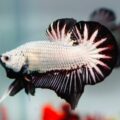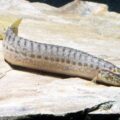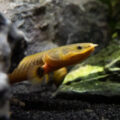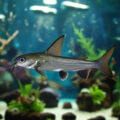Meet the Half-Banded Spiny Eel, a quirky, social oddball with striped charm and a knack for slipping out of tanks. In this article we share how to care for this freshwater fish with tips on habitat setup, feeding, and more.
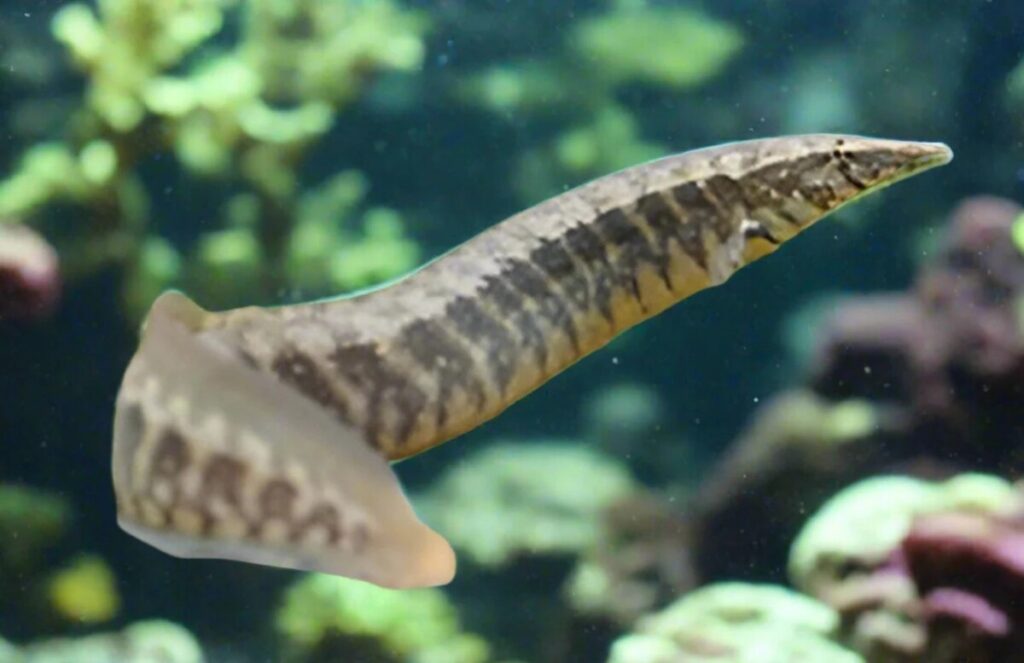
Introduction
The Half-Banded Spiny Eel isn’t your average freshwater fish. It’s an oddball through and through, both in looks and behavior.
Here’s a quick Macrognathus circumcinctus intro. The Half-Banded Spiny Eel is a tropical eel species that has a slender 8-inch (20 cm) long body with distinct half-banded stripes running across a yellowish to brown base.
They’re also relatively peaceful, fun to watch, and they’re known for being sneaky little escape artists. It’s the perfect pick for aquarists who enjoy observing quiet but fascinating fish behavior.
Want to know more about small spiny eel care or how to make your aquarium a perfect home for this striped explorer?
In this half-banded spiny eel overview, you’ll find everything you need to know about their behavior, tank setup, diet, and how to keep them safe and secure.
Author’s Note: Check out our post on The 13 Freshwater Aquarium Eels That Can be Kept as Pets for even more eels!
Natural Habitat and Origins

The Half-Banded Spiny Eel is native to slow-moving rivers, rice paddies, and floodplains of South and Southeast Asia, particularly in India, Bangladesh, Nepal, and Thailand.
In the wild, these Southeast Asia freshwater fish spend a lot of time partially buried in sand or leaf litter, peeking out from beneath plants or debris. It’s a lifestyle that’s both defensive and practical.
They depend on their camouflage and their ability to slither through tight spots to avoid predators and find food.
The half-banded eel’s natural habitat is full of cover, like plants, driftwood, and rocks, which are important in helping them feel at home in your tank. This spiny eel environment has a huge influence on how the eel behaves in captivity.
So, when replicating the Macrognathus circumcinctus habitat in a home aquarium, think soft substrate, subdued lighting, and a warm, slightly acidic to neutral pH.
Identifying the Species

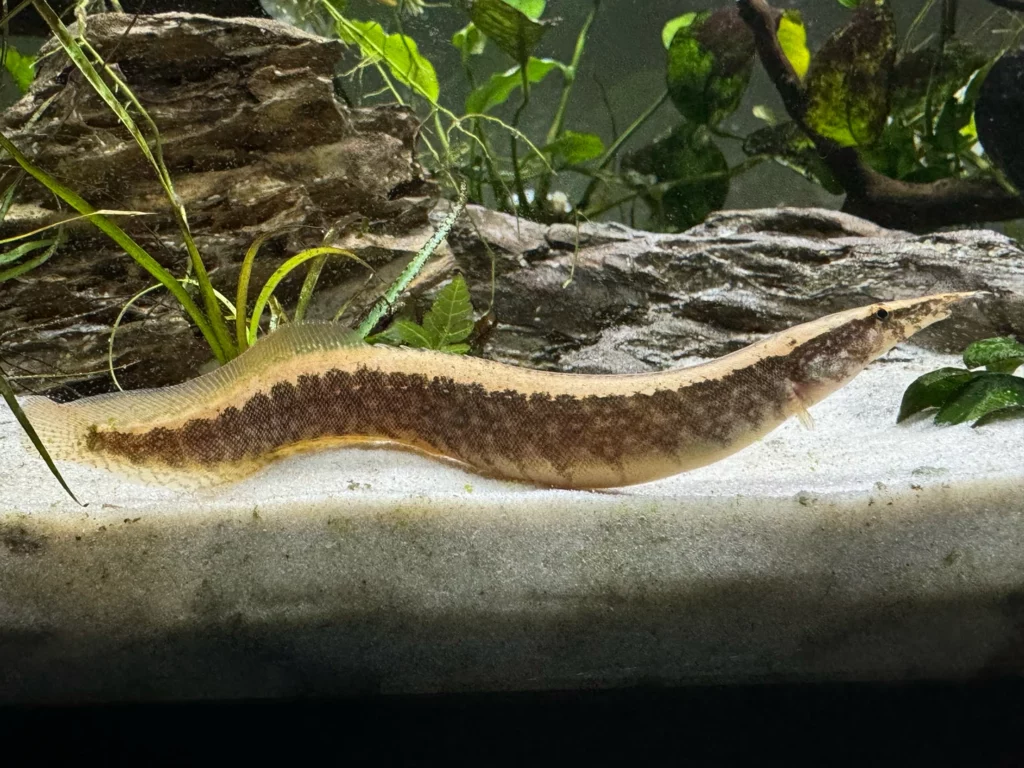
In case you’re wondering how to identify a half-banded eel, here’s a descriptive guide. Macrognathus circumcinctus features include distinctive dark bands that wrap around its slender, elongated body.
The spiny eel markings usually appear as semi-circles or half-rings, which gives the eel a subtle striped pattern that stands out against its brown or olive base color.
They can grow up to 8 – 10 inches long, which makes them a manageable oddball species for most medium-sized aquariums.
The male eels are typically slightly slimmer than the females. All these characteristics help in distinguishing small spiny eels from other eels.
Aquarium Setup and Decoration

For a half-banded eel tank setup, a 30-gallon tank is the minimum for one adult, but a 40-gallon breeder or larger is better if you plan to keep a small group.
The best substrate for spiny eels like Macrognathus circumcinctus is a fine sand substrate that allows them to safely burrow into without damaging their skin. Using gravel can be too rough and cause injuries.
Use soft, spiny eel aquarium decor like driftwood, smooth stones, and PVC pipes. Not only does it help them feel at home, but it also gives them plenty of hiding options. Caves, dense plants, and decor that mimic natural structures provide great fish tank hiding spot ideas.
Don’t forget: Half-Banded Spiny Eels are notorious escape artists. So, make sure your tank has a tight-fitting lid!
Water Parameters and Maintenance

Penn-Plax Cascade All-in-One Aquarium Canister Filter
Found On Amazon
These eels are hardy but sensitive to sudden water changes or poor conditions. See ideal water parameters for spiny eels:
| Temperature | 75–82°F |
| pH | 6.5–7.5 |
| Water flow | Low to moderate |
Here are some spiny eel care tips you need.
- Change 20-25% of water every week to help maintain stability and keep the nitrate levels low.
- Use a sponge filter or low-flow canister as your filtration system. Weekly water changes of 20-25% help maintain stability.
Author’s Note: Checkout the post on The 7 Best Aquarium Canister Filters Reviewed (2024) for an in-depth guide on choosing the right filter for your aquarium!
Don’t skip these half-banded eel water conditions and care tips. Your spiny eel might not complain loudly, but it’ll definitely feel the effects of bad water quality.
Diet and Feeding Routine
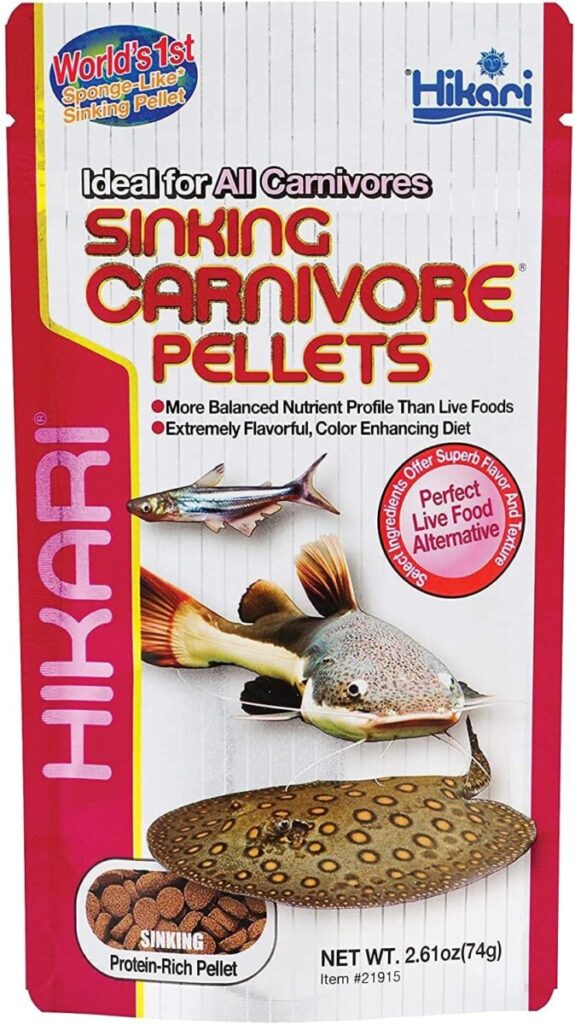
Sinking Carnivore Pellets for Pet
Found On Amazon
Wondering what to feed a half-banded spiny eel? This half-banded eel feeding guide is just what you need. These carnivorous oddballs love live or frozen food.
The spiny eel’s diet plan mostly contains bloodworms, blackworms, daphnia, mosquito larvae, brine shrimps, and chopped earthworms. They’ll usually ignore dry foods, so frozen or live is the way to go.
Carnivorous tropical fish feeding, especially for Macrognathus circumcinctus, is best done at night or in low light. They tend to be shy and might ignore food during the day, especially if there’s too much activity in the room.
They can be trained to accept freeze-dried or even pellet food over time, but always make sure the food sinks. They’re bottom feeders and won’t chase flakes at the top of the tank.
Offer small meals 3-4 times per week. Avoid overfeeding, because these quirky oddballs have slow metabolisms and can easily bloat.

Half-banded spiny eels are generally peaceful, bottom-dwelling fish, and they do best with equally chill tank mates.
They enjoy the company of their own kind. Although you can keep just one, they tend to be more confident and active when housed in small groups of 3-5. Just make sure the tank is big enough and there are plenty of hiding spots.
Some compatible fish for spiny eel include:
- Peaceful bottom dwellers like loaches
- Medium-sized schooling fish like rasboras
- Calm surface swimmers like hatchetfish or gouramis
Avoid overly aggressive species or fin-nippers. Just to be safe, avoid housing them with fish small enough to fit in their mouths.
Even if they aren’t hunters by nature, they may get curious enough to take a bite.
Make sure half-banded eel tank mates won’t outcompete the eel for food. These quirky explorers are shy and need time to find their meals.
Common Health Risks and Prevention
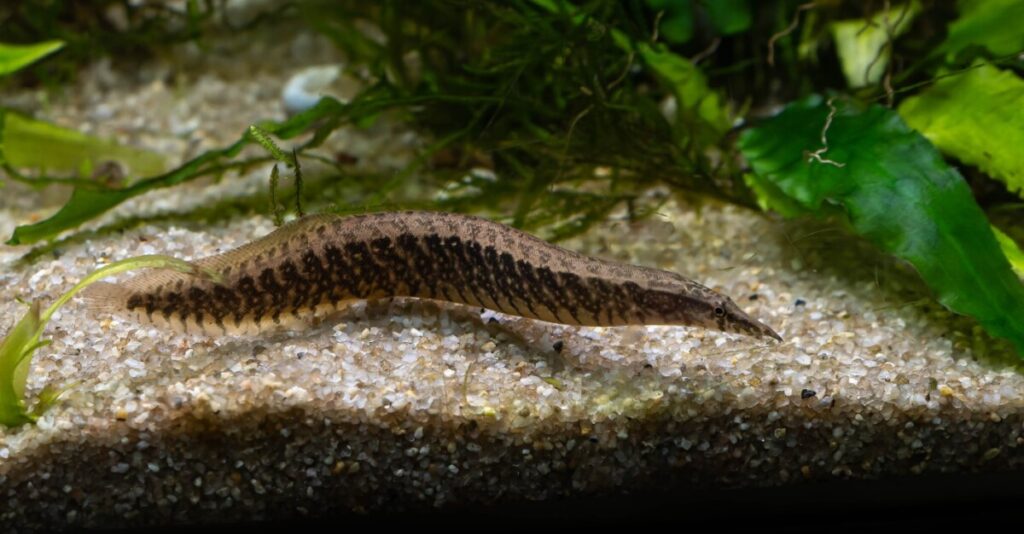
Care must be taken when keeping a sensitive skin aquarium species like Half-Banded Spiny Eels. While these eels are fairly hardy, they can be vulnerable to common spiny eel diseases like:
- Bacterial infections from poor water quality
- Internal parasites (common in wild-caught specimens)
- Cuts and scrapes from sharp decor
- Stress from aggressive tank mates.
Preventing eel infections is possible by quarantining any new fish or plants before adding them to the tank. Half-banded spiny eels are scaleless, so in case of an infection, use marine salt and avoid copper-based medications.
Half-banded eel health care also involves monitoring your eel closely for signs of illness. If your eel is acting strange, hiding more than usual, or not eating, it’s worth doing a water test and checking for signs of illness.
Key take away form this section is to maintain proper and stable water parameters, without this the tank’s water quality can degrade, which can cause a wide range of issues from cloudy aquarium water to illness and mass die off.
Lifespan and Care Commitment
The good news? These eels are fairly hardy once settled. With proper care, the half-banded eel’s lifespan can range from 6 to 10 years.
Mid-level aquarist fish choices are often those that offer companionship for about a decade.
Long-term spiny eel care involves maintaining optimal water conditions and regular observation to help catch health problems early.
A peaceful, well-maintained tank goes a long way towards ensuring your eel stays happy and healthy.
In this Macrognathus circumcinctus guide, you’ll see that these oddballs need a tank with a very secure lid. So, to enjoy your eel long-term, make sure your home aquarium is escape-proof.
Conclusion: Why Choose the Half-Banded Eel?
Reasons to keep a Half-Banded Spiny Eel? That’s easy! It’s a small, peaceful, and unique aquarium centerpiece fish with an interesting look, a curious behavior, and a social nature.
Here’s a quick half-banded eel care summary: they need a secure, well-decorated tank with soft substrate, stable water parameters, and a steady supply of live food.
Macrognathus circumcinctus is a solid beginner spiny eel choice for hobbyists looking to dive into the world of oddball fish. But you must be a little patient and pay attention to details.
So, if you’re ready to care for a fish that’s equal parts mysterious, playful, and a little mischievous, this striped escape artist might just be the perfect addition to your aquatic family.


